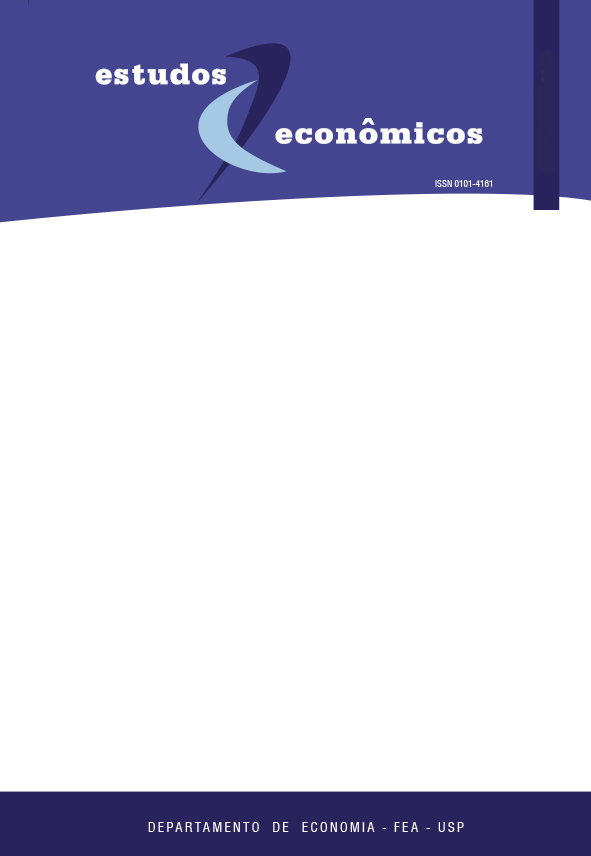Ciclos reais e política fiscal no Brasil
DOI:
https://doi.org/10.1590/S0101-41612012000100003Keywords:
real business cycle, fiscal policy, public capitalAbstract
We develop a real business cycle model that includes the government sector and public capital, in order to analyze the effects of fiscal shocks over the business cycle and to account for the main stylized facts of postwar Brazilian fiscal policy (1950-2006). The model captures quite well the main characteristics of the fiscal variables along the business cycle, namely, the greater volatility of the government spending (consumption and investment) compared to the private sector spending and the procyclical behaviour of the fiscal policy. Although the tax burden is the fiscal variable that fluctuates less along the business cycle, it is the most important one to explain the output volatility, besides productivity.
Downloads
References
Ambler, S., and Paquet, A. (1996) “Fiscal spending shocks, endogenous government spending, and real business cycles” Journal of Economic Dynamics and Control 20, 237-56.
Aschauer, D. (1989), “Is public expenditure productive?” Journal of Monetary Economics, 23, p. 177-200.
Barro, R. (1990), “Government spending in a simple model of endogenous growth.” Journal of Political Economy, v. 98, p.103-125.
Barro, R., and Sala-i-Martin, X. (1992), “Public Finance in Models of Economic Growth,” Review of Economic Studies 59, 645-662.
Baxter, M. and King, R.G. (1993) “Fiscal policy in general equilibrium,” American Economic Review 83, 315-34.
Braun, R.A. (1994) ‘Tax disturbances and real economic activity in the postwar United States,” Journal of Monetary Economics, 33, 441-62.
Bugarin, M. e Ellery Jr., R. (2002) “Liquidity Constraints and the Behavior of Aggregate Consumption over the Brazilian Business Cycle” Estudos Econômicos v. 32, n. 4, 551-576.
Carvalho, F. A., e Valli, M. O. “An Estimated DSGE Model with Government Investment and Primary Surplus Rule: The Brazilian Case.” XXXII Encontro Brasileiro de Econometria, 2010, Salvador.
Christiano, L.J., and Eichenbaum, M. (1992) “Current real-business-cycle theories and aggregate labor-market fluctuations,” American Economic Review 82, 430-50.
Cooley, T. F., Prescott, E. C. (1995) “Economic growth and business cycle”. Cooley, T. F. (ed.). Frontiers of business cycle research. Princeton University Press.
Ellery R. G., JR., Gomes, V., Sachsida, A. (2002) “Business cycle fluctuations in Brazil”. Revista Brasileira de Economia, v. 56, n. 2, p. 269-308.
Ferreira, P. C. e Malliagros, T. (1998) “Impactos produtivos da infra-estrutura no Brasil- 1950/95.”, Pesquisa e Planejamento Econômico, v.28, n.2, p.315-338.
Gomes, V.; Pessoa, S., Veloso, F. (2003) “Evolução da produtividade total dos fatores na economia brasileira: uma análise comparativa.” Pesquisa e Planejamento Econômico, v.33, p.389-434.
Hansen, G.D. (1985), “Indivisible Labor and the Business Cycle,” Journal of Monetary Economics 16, 309-327.
Kamps, C. (2004), “The Dynamic Macroeconomic Effects of Public Capital: Theory and evidence for OECD countries.” Springer.
Kanczuk, F. e Botelho, F. (2003), “Preços Rígidos e Ciclos Reais Brasileiros”. Pesquisa e Planejamento Econômico, v.33, n.2.
Kanczuk, F. (2004a), “Ciclos Reais Brasileiros em Dois Setores”. Estudos Econômicos, v. 34, n. 1, 43-72.
Kanczuk, F. (2004b), “Real interest rates and Brazilian business cycles”. Review of Economic Dynamics, v. 7, 436-455.
Kocherlakota, N. e Yi, K. (1996) “A simple time series test of endogenous vs. exogenous growth models; an application to the United States.” The Review of Economics and Statistics, vol. 78, p. 126-134.
Kydland, F.E., and Prescott, E.C. (1982) “Time to build and aggregate fluctuations,” Econometrica 50, 1345-70.
Lansing, K.J. (1998). “Optimal Fiscal Policy in a Business Cycle Model with Public Capital,” Canadian Journal of Economics, 31
McGrattan, E.R. (1994) “The macroeconomic effects of distortionary taxation,” Journal of Monetary Economics 33, 559-71.
Morandi, L., Reis, E. J. (2003) “Estimativa do estoque de capital fixo-Brasil, 1950-2000.” Rio de Janeiro: IPEA, nov. 2003, mimeo.
Mussolini, C.C. e Teles, V. (2010) “Infraestrutura e Produtividade no Brasil” Revista de Economia Política, v. 30, n. 4, 645-662.
Neumeyer, P. A., and Perri, F. (2005). “Business Cycles in Emerging Economies: The Role of Interest Rates.” Journal of Monetary Economics. 52 (March): 345–80.
Prescott, E. C. (2002) “Prosperity and Depression” American Economic Review, 92:1-15.
Otto, G. and Voss, G. M. (1998) ‘‘Is Public Capital Provision Efficient?’’. Journal of Monetary Economics 42: 47–66.
Rebelo, S. (2005). “Real Business Cycle Models: Past, Present, and Future” Scandinavian Journal of Economics 107(2), 217-238.
Schmitt-Grohe, S. and Uribe, M. (2004). “Solving dynamic general equilibrium models using a second-order approximation to the policy function”. Journal of Economic Dynamics & Control, 28, 755 – 775.
Silva, F. S., e Portugal, M. S. (2010) “Impacto de Choques Fiscais na Economia Brasileira: Uma Abordagem DSGE.” XXXII Encontro Brasileiro de Econometria, 2010, Salvador.
Talvi, E. and Végh, C. E. (2005). “Tax Base Variability and Pro-cyclical Fiscal Policy.” Journal of Development Economics 78 (October): 156-190.
Val, P. R. C., Ferreira, P. C. G. (2001) “Modelos de ciclos reais de negócios aplicados à economia brasileira”. Pesquisa e Planejamento Econômico, v. 31, n. 2, p. 213-248.
Downloads
Published
Issue
Section
License
Copyright (c) 2012 Caio Cesar Mussolini, Vladimir K. Teles

This work is licensed under a Creative Commons Attribution-NonCommercial 4.0 International License.
By submitting an article, the author authorizes its publication and attests that it has not been submitted to any other journal. The original article is considered final. Articles selected for publication are proofread for grammatical and orthographic errors. The journal does not pay rights for published articles. The Institute of Economic Research from the School of Economics, Business and Accounting of the University of São Paulo (Instituto de Pesquisas Econômicas da Faculdade de Economia, Administração e Contabilidade da Universidade de São Paulo) owns the journal's copyright.





 Atualizado em 14/08/2025
Atualizado em 14/08/2025